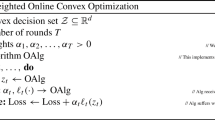Abstract
Computer game-playing programs repeatedly calculate minimax elements μ = min i max j M ij of large pay off matricesM ij . A straightforwardrow-by-row calculation of μ scans rows ofM ij one at a time, skipping to a new row whenever an element is encountered that exceeds a current minimax. Anoptimal calculation, derived here, scans the matrix more erratically but finds μ after testing the fewest possible matrix elements. Minimizing the number of elements tested is reasonable when elements must be computed as needed by evaluating future game positions. This paper obtains the expected number of tests required when the elements are independent, identically distributed, random variables. For matrices 50 by 50 or smaller, the expected number of tests required by the row-by-row calculation can be at most 42% greater than the number for the optimal calculation. When the numbersR, C of rows and columns are very large, both calculations require an expected number of tests nearRC/InR.
Similar content being viewed by others
References
J.C.C. McKinsey,Introduction to the Theory of Games (McGraw-Hill, New York, 1952).
C.E. Shannon, Programming a computer to play chess, Phil. Mag. 41(1950)256.
D. Knuth and R. Moore, An analysis of alpha-beta pruning, Artificial Intelligence 6(1975)293.
J. Pearl, Asymptotic properties of minimax trees and game searching procedures, Artificial Intelligence 14(1980)113.
T.A. Marsland, Relative efficiency of alpha-beta implementations,IJCAI Conf. Proc. No. 8, Vol. 2, Karlsruhe (1983) p. 763.
E.T. Copson,An Introduction to the Theory of Functions of a Complex Variable (Oxford, London, 1935).




